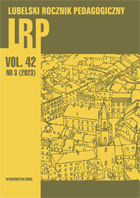SPECYFIKA RYSUNKU NIEWIDOMYCH UCZNIÓW. NA
PRZYKŁADZIE REPREZENTACJI SCHEMATU DRZEWA
SPECIFICITY OF DRAWING OF BLIND STUDENTS. THE TREE DIAGRAM
REPRESENTATION AS A CASE STUDY
Author(s): Ewa NiestorowiczSubject(s): Educational Psychology, Health and medicine and law, Pedagogy
Published by: Wydawnictwo Naukowe Uniwersytetu Marii Curie-Sklodowskiej
Keywords: blind; drawing; stages of artistic development; drawing patterns and conventions; typology of tree forms in artistic creations;
Summary/Abstract: Introduction: For centuries, drawing has been a creative form of human expression. The authorshapes the image of the phenomenon according to his own sensory experience and imagina-tion and the knowledge carried by the language and transmitted through culture. This articleconcerns the representation of real-world phenomena in drawings by individuals who are com-pletely blind from birth.Research Aim: The research goal is encapsulated in the question: Do blind individuals go thro-ugh a similar typology in representing tree forms in their artistic development as sighted indivi-duals? I am particularly interested in the following issues: What aesthetic characteristics (formand uniqueness of perspective) distinguish the drawings by blind students? Are the patternsof sighted individuals similar to those constructed by blind individuals? Do blind individualspresent a distinct vision of the phenomenon based on their own imagination and sensory expe-riences?Method: The method of the research procedure involves the analysis of art works created in theprocess of the act of drawing. In order to gain knowledge about the created phenomenon, theinterview method and participant observation during the creative act were used.The subject of analysis consists of convex drawings on microgrooved foil. The formal layer ofthe artwork in the drawings of trees by blind students will be subjected to analysis. The imagecomponents of the phenomenon will be analysed in relation to the typology of tree forms in theartistic creations of sighted children, as proposed by Stanisław Popek (1985). In analysing thegraphical representations of the phenomenon, I will also refer to studies on the development ofa child’s artistic abilities presented by specialists such as Szuman (1990), Lowenfeld and Brittain(1977), Arnheim (1974/2004), Popek (2010) and Uberman (2019).Results: Based on the analysis of drawings, it can be noted that the blind create the phenome-non of the tree in the following ways: a) according to the pattern of the sighted, b) also develo-ping their own, individual patterns.Conclusion: Delayed stages in the artistic development of blind people can be observed inrelation to their sighted peers. The drawing patterns of blind people sometimes follow those ofsighted people, but sometimes blind people develop their own, different patterns. The typologyof the tree form follows a different path in blind people than in sighted people. There is a pro-gression in the tree drawings of blind people, which is related to the development of the formof the depicted phenomenon.
Journal: Lubelski Rocznik Pedagogiczny
- Issue Year: 42/2023
- Issue No: 3
- Page Range: 103-117
- Page Count: 15
- Language: Polish

